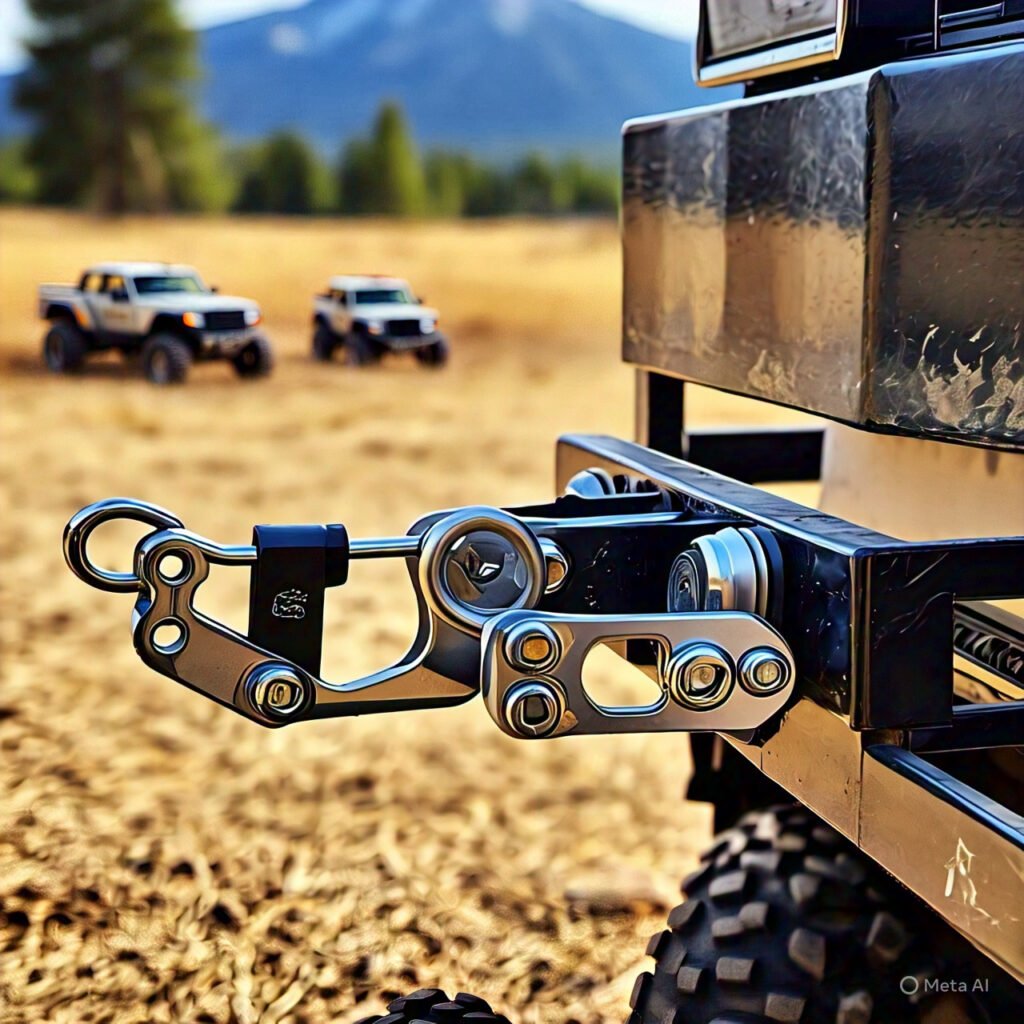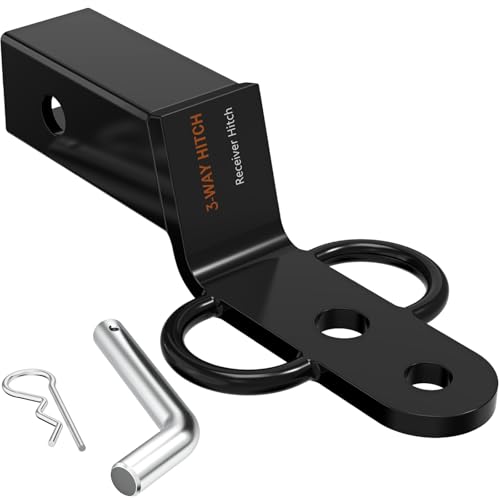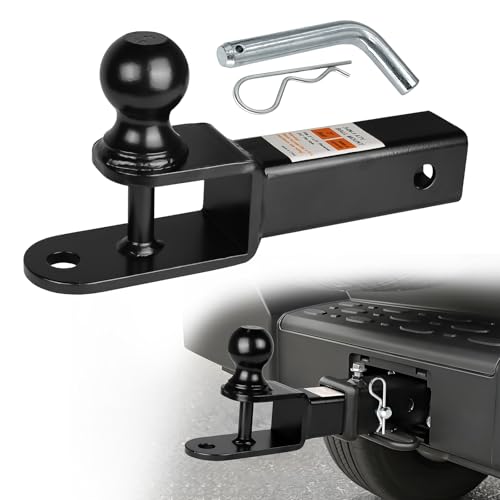All-Terrain Vehicles (ATVs) are versatile machines designed for various recreational and utility purposes.
To maximize their functionality, selecting the appropriate trailer hitch is crucial for off-road use.
There are several types of ATV trailer hitches, each with unique features and applications that cater to different hauling requirements.
One prevalent type is the receiver hitch.
This hitch features a square tube design, allowing for easy attachment and detachment of different accessories, such as ball mounts and cargo carriers.
The receiver hitch is especially favored for its adaptability, supporting varying weight capacities based on the vehicle’s specifications.
This kind of hitch is highly recommended for trailers that require flexibility in load management and are routinely utilized for transporting equipment or gear across rugged terrains.
Another common option is the ball mount hitch, which is specifically designed to connect a trailer with a ball coupler.
Ball mounts are available in various sizes and configurations, providing the ability to choose a hitch based on the trailer’s weight and size.
This type of hitch is exceptionally useful for traditional towing purposes,
making it an optimal choice for those who frequently transport trailers loaded with recreational vehicles or agricultural supplies in off-road conditions.
Clevis hitches, characterized by a U-shaped design, are also notable for their strength and stability.
This hitch style is typically employed in towing applications where heavy loads or heavy-duty trailers are involved.
Clevis hitches are particularly beneficial for moving heavy machinery or equipment in off-road scenarios, as they provide secure and reliable fastening.
Understanding the distinct features of each hitch type allows users to select the most suitable option tailored to their off-road hauling needs.
Hitch Classes and Weight Ratings
Understanding hitch classes and weight ratings is crucial for ensuring safe and effective towing with an ATV.
Hitch classes are categorized based on their weight capacity and compatibility with various towing systems.
The fundamental classes range from Class I,
which typically supports 1,000 pounds, to Class V, which can handle loads of up to 20,000 pounds.
Each class has its specific applications, and properly matching the hitch to your ATV’s towing capacity and the trailer’s weight is vital to avoid accidents and damage.
When selecting a hitch, it is imperative to consider both the towing capacity of the ATV and the weight of the trailer, including its cargo.
Exceeding the rated capacity of the hitch can lead to significant safety issues,
including trailer sway or hitch failure, which may result in loss of control while driving.
Therefore, always verify your ATV’s manufacturer specifications to determine the maximum towing capacity before purchasing a hitch.
In addition to matching the hitch class with the vehicle’s capacity, weight distribution is another factor that should not be overlooked.
An uneven load can stress the hitch and the ATV’s rear-end suspension system, potentially compromising handling and stability.
Utilizing a weight-distributing hitch can mitigate these risks by evenly distributing the tongue weight across the vehicle axles.
Before towing, it is advisable to assess the entire setup, ensuring that the hitch, pins, and clips are all rated for the intended load.
Properly securing the trailer with high-quality pins and clips further enhances the safety of the towing arrangement.
By adhering to these guidelines and understanding hitch classifications, ATV users can confidently tow their trailers while mitigating the risk of accidents and equipment failure.
Types of Hitch Pins and Clips
In the realm of ATV trailer hitches, understanding the various types of hitch pins and clips is crucial for ensuring secure and reliable functionality.
This section explores the common types used broadly in the industry: standard hitch pins with clips,
-
locking hitch pins,
-
clevis pins,
-
cotter pins,
-
and r-clips,
-
also known as hairpin clips.
Standard hitch pins are the most common and typically feature a simple design that allows for easy insertion and removal.
These pins often come with a securing clip that prevents the pin from falling out during operation,
ensuring the attached equipment remains secure.
However, while they provide basic functionality,
their lack of advanced security measures can be a concern in rugged off-road conditions.
Locking hitch pins offer an added layer of security, making them ideal for those concerned about theft or loss.
These pins employ a locking mechanism that keeps the hitch securely attached even in the harshest environments.
The use of a locking hitch pin is particularly recommended for those who frequently transport expensive or heavy equipment, as it deters unauthorized removal.
Clevis pins serve a different purpose, typically used to connect two components in a larger assembly.
Renowned for their strength and durability, clevis pins act as a hinge allowing for rotational movement while maintaining a secure connection.
Meanwhile, cotter pins and r-clips (or hairpin clips) enhance the security of hitches further by preventing accidental dislodgment of the main pin.
They fit snugly into a designated hole, effectively retaining the larger pin in place.
Selecting the appropriate hitch pin or clip is paramount for ensuring reliability in rugged off-road environments.
The chosen component must withstand the demands of terrain and ensure that equipment remains securely connected throughout travel.
Prioritize security, durability, and ease of use when assessing hitch pins and clips tailored to your specific ATV needs.
Determining the Correct Hitch Size
When selecting the appropriate hitch size for your all-terrain vehicle (ATV) trailer,
several key factors must be taken into account to ensure both safety and performance.
The first consideration is the receiver size, which refers to the square tube that connects the hitch to the vehicle.
Common receiver sizes include 1-1/4 inches and 2 inches.
To determine the right receiver size for your ATV,
it’s essential to refer to the manufacturer’s specifications,
as this will ensure compatibility with your particular model and trailer.
Next, attention should be given to the pin diameter.
The hitch pin is a critical component that secures the trailer hitch to the ATV, preventing any unwanted detachment during transport.
The diameter of the hitch pin typically corresponds to the receiver size;
therefore, a 2-inch receiver usually requires a pin diameter of 5/8 inch.
Carefully measure the receiver opening to verify the appropriate pin size,
as an incorrectly sized pin may lead to instability and potential accidents.
Additionally, the length of the hitch pin is another significant aspect that should not be overlooked.
A pin that is too short may not fully engage,
while one that is excessively long can create protrusions that are hazardous.
Generally, standard pin lengths range from 2 inches to 4 inches,
but measuring the receiver and factoring in the specific configuration of the hitch is paramount to achieving the correct fit.
It is crucial to ensure that all hitch components,
including the receiver, pin diameter, and pin length,
are compatible and properly sized for optimal safety.
Failure to select the correct hitch can lead to dangerous situations on the road or trail, resulting in potential damage to both the ATV and the trailer.
Taking the time to accurately measure and choose the appropriate hitch size can significantly enhance your off-road experience.
Benefits of Trailer Hitches for Off-Road Activities
Trailer hitches play a crucial role in enhancing the versatility and functionality of all-terrain vehicles (ATVs) during off-road adventures.
One of the primary benefits of using a trailer hitch is the ability to haul substantial gear securely,
making any outing more efficient and enjoyable.
Whether embarking on a camping trip, hunting expedition, or work-related tasks, an appropriately chosen hitch allows for the transportation of vital equipment and supplies.
For outdoor enthusiasts, the practicality of a trailer hitch cannot be overstated.
Campers can quickly load their tents, sleeping bags, cooking equipment, and additional necessities onto a trailer,
enabling them to access remote locations that may otherwise be difficult to reach.
This capability significantly enhances the overall camping experience,
allowing for longer excursions in nature without the worry of limited gear.
Additionally, the option to transport hunting equipment—such as blinds, firearms, and decoys
—makes off-road hunting trips more organized and effective, facilitating a successful outing.

Moreover, trailer hitches can be highly beneficial for work-related activities in rugged environments.
Farmers and construction workers can take advantage of the towing capacity offered by an ATV equipped with a trailer hitch.
This enables them to easily transport tools, supplies, or even small machinery across challenging terrain, improving productivity and efficiency on the job.
By utilizing the right towing equipment, ATV users can significantly expand the range of tasks they undertake while enjoying the outdoors.
Incorporating a trailer hitch into an ATV setup undoubtedly enhances the overall experience of off-road activities.
The increased hauling capacity allows for more comprehensive adventures, whether for recreation or work, ultimately leading to unforgettable outdoor escapades.
How to Properly Attach a Trailer to an ATV
Attaching a trailer to an All-Terrain Vehicle (ATV) requires a methodical approach to ensure safety and efficiency during off-road adventures.
Follow these step-by-step instructions to effectively connect your trailer using a hitch, pin, and clip.
Begin by selecting the appropriate trailer hitch that matches the specifications of your ATV.
It is crucial to verify the weight capacity of both the ATV and the trailer,
ensuring that they are compatible.
Once the correct hitch is selected, position the trailer tongue towards the ATV’s rear.
Next, lift the trailer tongue and align it with the ATV hitch.
Ensure that the hitch’s ball receptacle aligns with the ball on the trailer affixed to the hitch.
With the trailer in position, lower the tongue onto the hitch, making sure that it fits snugly against the ball.
It is important to check that the hitch mechanism is properly engaged, preventing any risk of disconnection during transit.
After securing the trailer onto the hitch, insert the hitch pin through the designated hole of the hitch’s structure.
The pin must pass through both the hitch and the trailer tongue, effectively locking them together.
A retaining clip should then be pushed onto the end of the hitch pin to prevent it from loosening.
This finalizes the attachment process.
Additionally, perform a thorough inspection of all connections and adjustments.
Make sure that the trailer is securely attached, the pin is locked in place, and there are no loose components.
Engage the safety chains or straps if applicable,
as they serve as an added safety measure to keep the trailer connected, even if the primary hitch fails.
By adhering to these guidelines, you can ensure that your trailer is properly attached to your ATV, providing a safer and more enjoyable off-road experience.
Always prioritize safety to prevent accidents while out on the trails.
Essential Safety Considerations for Off-Road Towing
Towing with an all-terrain vehicle (ATV) presents unique challenges, particularly when navigating off-road terrain.
Ensuring safety should be the top priority for all ATV operators.
One of the principal aspects to address is weight distribution;
it is crucial to ensure that the weight of the load being towed is evenly distributed across the ATV and trailer.
This balance helps maintain stability and control, reducing the risk of tipping or losing traction.
Equally important is verifying secure connections between the ATV and the trailer.
Loose connections can lead to dangerous accidents, as they may cause the trailer to sway or detach unexpectedly.
Before embarking on any journey, operators should double-check that all hitch pins and clips are properly inserted and secured.
The use of safety chains is also highly recommended; these chains act as a backup connection to minimize the risk of disconnection while towing.
Conducting thorough pre-trip checks can prevent many potential issues.
Operators should inspect the ATV’s tires, brakes, and overall functionality before hitting the trails.
Ensuring that the towing equipment is in good condition limits the likelihood of breakdowns that can render off-road adventures hazardous.
Attention to detail during these checks contributes to ensuring a safe experience while towing.
Driving techniques also play a crucial role in off-road towing safety.
Operators should adopt a cautious approach, particularly on uneven or challenging terrain.
Slower speeds allow for better control and the ability to react to sudden obstacles.
Utilizing smooth acceleration and deceleration techniques minimizes the risk of incidents caused by abrupt movements.
Additionally, staying vigilant and recognizing the limits of both the ATV and the trailer will enhance overall safety on the trails.
Maintenance Tips for Hitches, Pins, and Clips
To ensure the optimal performance and reliability of your ATV trailer hitches, pins, and clips, regular maintenance is essential.
Maintaining these components not only prolongs their lifespan but also enhances safety during off-road activities.
Here are some practical maintenance tips to consider.
First and foremost, cleanliness is crucial.
Dirt and debris can accumulate on your hitches, pins, and clips, leading to friction and potential failure.
After each off-road adventure, take the time to clean the components thoroughly with a soft brush and mild detergent.
Be sure to eliminate any mud or grime, focusing on crevices where particles can get lodged.
Rinse well and allow the parts to dry completely to prevent rust formation.
Lubrication plays a pivotal role in the maintenance of trailer hitches.
Apply a suitable lubricant, preferably a waterproof grease or a silicone-based product, to moving parts, such as the hitch connection points and pins.
Regular lubrication reduces wear and tear, minimizes noise, and ensures smooth operation.
It is advisable to check your trailer hitch’s manufacturer’s guidelines for specific recommendations regarding lubrication types and intervals.
Additionally, implementing a routine inspection schedule is important for identifying wear and tear.
Inspect hitches, pins, and clips for signs of corrosion, cracks, or bending.
If any components show significant wear, it is crucial to replace them immediately to avoid failures during operation.
Pay close attention to the pins that secure the hitch, ensuring they fit snugly and securely hold the trailer in place.
In maintaining ATV trailer hitches, pins, and clips, consistency in performing these tasks will promote longevity and reliability.
Proper care will lead to safer off-road experiences, ultimately enhancing the overall enjoyment of your adventures.
Factors to Consider When Purchasing Towing Components
When selecting ATV trailer hitches, pins, and clips, several critical factors come into play.
First and foremost, durability should be a primary consideration.
The towing components must withstand the rigors of off-road conditions,
including rough terrain, extreme weather, and potential impacts.
Investing in high-quality hitches and pins crafted from robust materials can significantly enhance their lifespan,
ensuring they perform reliably when needed.
Look for products that are specifically designed for trailering, as these are generally built to endure the specific stressors associated with towing.
Material quality is another crucial aspect of your purchasing decision.
Often, the best choices for hitches and pins include steel and aluminum.
Steel hitches tend to offer excellent strength and resistance to bending, while aluminum components are lighter, which can benefit speed and maneuverability.
Always consider the weight rating of the hitch or pin, matching it with your ATV’s towing capacity and the weight of the load being transported to ensure safe operation.
Ease of use is also important. Components that can be swiftly attached and detached save valuable time,
especially when you are eager to hit the trails.
For clips, consider mechanisms that allow quick securing yet provide reliable hold against vibrations and jarring motions caused by off-road driving.
Compatibility is another factor; ensure that the hitch and pins are suited for both your specific ATV model and the type of trailer you intend to use.
Some hitches may have adjustable features allowing them to fit various ATV styles and sizes,
making them more versatile choices.
By thoughtfully evaluating these criteria—durability, material quality, ease of use,
and compatibility—you can make well-informed decisions when purchasing ATV trailer hitches, pins, and clips,
ultimately enhancing your off-road experience.
Conclusion
In navigating the world of ATV trailer hitches, pins, and clips, understanding their significance is paramount for ensuring safe and efficient off-road towing.
Each component serves a distinct purpose, contributing to the overall functionality and security of your ATV while hauling loads.
As discussed, selecting the right hitch is critical;
it forms the backbone of your towing setup and must be compatible with both your ATV and the trailer.
The wrong hitch can lead to instability, potentially jeopardizing not only your safety but also that of others on the trail.
Equally important are the pins and clips that secure the hitch to the ATV.
These small yet vital components play a crucial role in preventing detachment during transit.
Quality pins and clips, designed to withstand the rigors of off-road environments,
are essential to ensure that your hitch remains securely fastened regardless of the terrain.
When choosing these components, consider their material and design, prioritizing durability and ease of use.
Moreover, maintaining your hitch, pins, and clips is just as important as selecting them wisely.
Regular inspections can help identify wear and tear, ensuring that your setup remains reliable over time.
Proper maintenance not only prolongs the lifespan of these components but also enhances safety during your off-road excursions.
Taking the time to invest in quality components and maintenance practices is a worthwhile endeavor for any ATV enthusiast.
Ultimately, the combination of the right hitch, pins, and clips is essential for a seamless off-road experience.
By prioritizing safety and functionality in your choices,
you can enhance the joy of your ATV adventures while minimizing risks associated with towing.
With thoughtful consideration of these critical elements, you can set yourself up for successful, worry-free journeys through rugged terrain.
Thanks 👍 👍









